
Review sample provided by XACT
Retail prices in the Netherlands:
XACT S1 Music Server: 12.000 euro
XACT Phantom LAN cable 1.2m: 3.000 euro
XACT Phantom LAN USB 1.2m: 3.000 euro
Six years in the making, the XACT S1 Music Server was created by Marcin Ostapowicz, the founder of the JCAT and JPLAY brands and author of some of the most innovative high-end audio products, such as audiophile Network Switches, Power Supplies, USB cards, and Network cards, as well as a range of cables. As the maker explains on the XACT website, the creation of XACT S1 stems from his quest to create a superbly sounding digital audio transport for himself, which brought him into high-end audio hardware development.
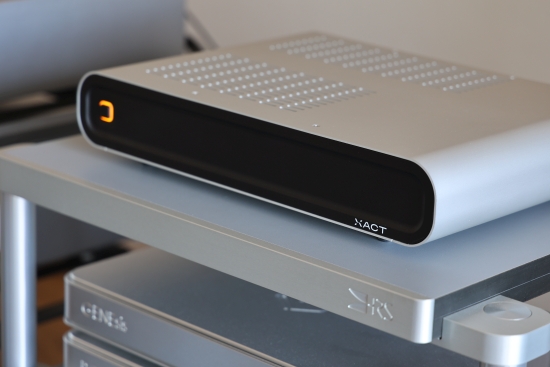
Whereas most competing music server designs use an off-the-shelf PC motherboard, Marcin has created everything inside the S1 entirely from the bottom up. That includes a 100% linear power supply with only linear regulators and no switching components, as well as a fully proprietary motherboard. The development of the server in this shape started in 2016. After three years, there was a final motherboard, and the following three years were strictly dedicated to fine-tuning, involving hand-picking selected components and meticulously testing all variables by ear.
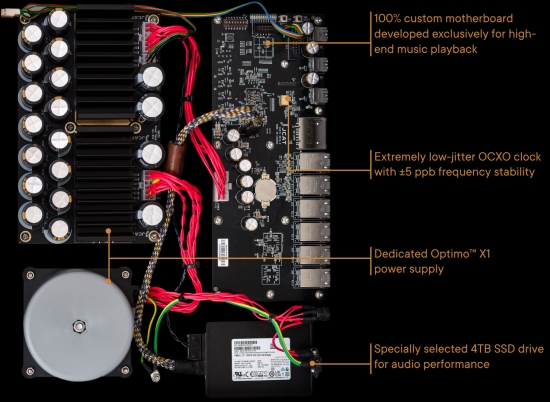
Above, the custom building blocks can be seen – no standard motherboard here!
As Marcin explains, standard motherboards have noisy power converters that interfere with other hi-fi components, and efforts at mitigating this do not address the root cause. Therefore, developing an entirely new motherboard from scratch with only audio playback in mind was the only way to go with XACT S1.
The hardware is very important, but there’s more to making a good server. During more than 10 years of developing JPLAY, it has also become clear that the software has as much impact on the sound quality as the hardware platform itself. Therefore, the XACT Operating System was written from scratch and optimized for the hardware. Marcin explored all possible optimizations of the operating system and player’s code, ultimately identifying the most harmonious combination for the S1’s hardware.
The S1 synthesizes all the audio research findings and experience in developing innovative audiophile hardware (JCAT) and software (JPLAY), and every product developed over the years has made an important contribution towards creating the XACT S1.
Technical highlights
Housed in an aluminum case, the XACT S1 is a silent fanless design weighing 9KG with an extremely low-jitter OCXO clock with +/- 5PPB frequency stability, Nichicon Muse flagship capacitors, specially-selected Industrial-grade4TB SSD (8TB available on request) with XACT Link drive cable, an extremely resistant OS SD card developed for military conditions, and 2x USB Audio 2.0 outputs (main and without 5V power bus) via gold plated high durability EMI shielded USB connectors. Music can be imported easily from USB drives and over the network. The server supports native bit-perfect playback up to DSD512 & PCM hi-res up to 768 kHz, 16-32 bits. Supported file types include DSF, DFF, FLAC, Apple Lossless (ALAC), WAV, AIFF, and MQA (pass-through).
Server/Player Software
The S1 server runs proprietary XACT Femtoserver UPnP software that talks directly to the built-in XACT S1 player. As the software adheres to UPnP standards, the server can also stream to other players on the network to create a multi-room system. Likewise, the XACT S1 player can be streamed to from other UPnP libraries on the network.
The S1 is extremely simple to operate. It has only a power button that boots the device in 20 seconds. There are no other buttons and no settings to make on the server itself. Instead, the S1 is fully operated via a phone or tablet, and that’s where the available options and settings can be made neatly all in one place.
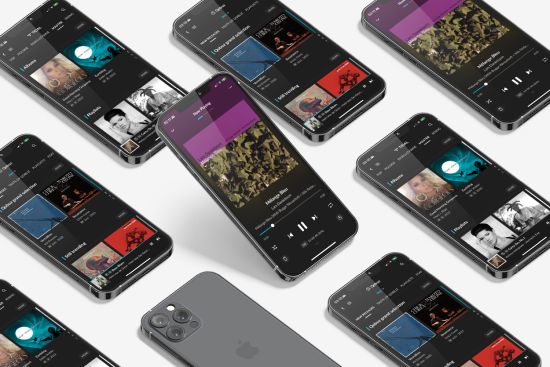
JPLAY for iOS Control App
The XACT S1 comes bundled with a lifetime subscription to JPLAY for iOS, which Marcin developed specifically for the XACT S1. The app runs on iPads and iPhones, and although it is not officially endorsed for MacOS, I found it runs perfectly fine on the original M1 MacBook Air.
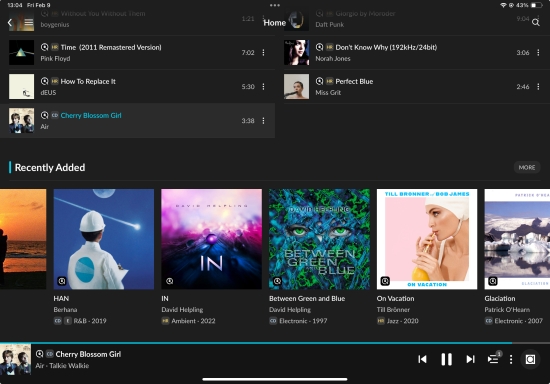
The design brief for JPLAY for iOS was not just to create a superb user interface but also to minimize the network traffic between the app and the audio endpoint to the absolute minimum to ensure the lowest possible network noise and, as a result, the best sound quality.
Having reviewed JPLAY for iOS earlier this year, I can confirm that the software does indeed extract even better sound than other apps. The purity of sound, UPnP’s inherent sonic stability, and JPLAY’s absolutely superb interface actually made me set Roon aside and switch to UPnP, controlled by JPLAY, as my favorite app!
If, like me, you were put off by the basic functionality of UPnP apps so far, you must try JPLAY. The software is a game changer.
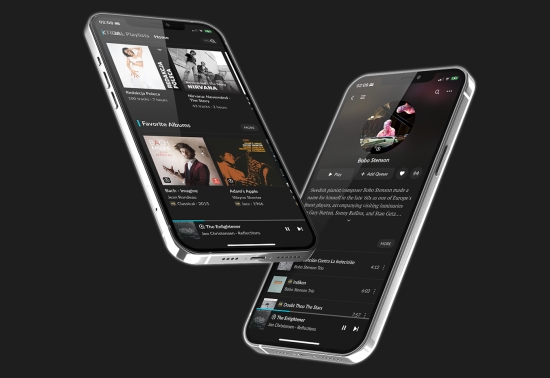
JPLAY provides intuitive control of all the expected functions and a bunch more, such as streaming and local files accessible in one place, native Tidal, Tidal MAX, and Qobuz discovery features, other albums by the selected artist, associated artists, artist bios, extended playlist management, advanced search and sort, aggregated activity statistics, and multiple library views. And that’s only the start.
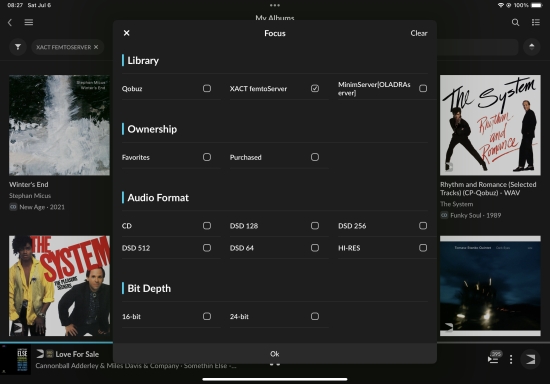
JPLAY also incorporates several features that were thus far only available in Roon. For instance, the app has full streaming service integration and automatically shows other versions of the same album, such as the Qobuz version of a local album, as well as suggestions for other artists I might like. Another rare feature is the possibility to add tracks to playlists no matter where you access them, be it on the associated album, in the Queue, or another playlist. A Radio function is also included. Initially introduced by Roon, this is another feature that you will not find in other UPnP apps. This super-handy function auto-selects and plays music at the end of the now-playing queue based on music played earlier, as well as direct user feedback. You can teach the algorithm by thumbing it up or down. And, to top it off, the app offers a Focus function, which lets you quickly and easily narrow down the search results.
For an in-depth report of JPLAY for iOS, please see the separate review.
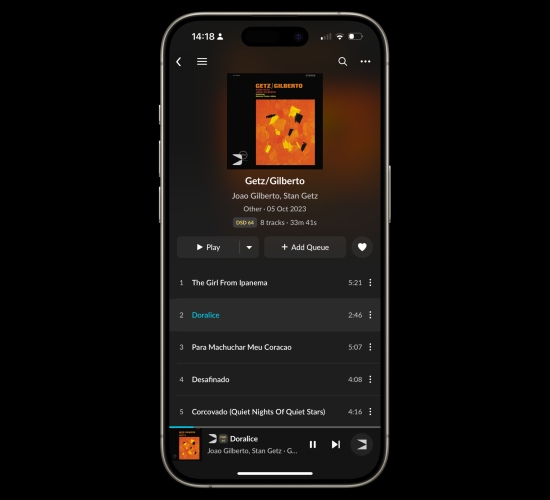
Next: Configuration, Review Context, and Foreword
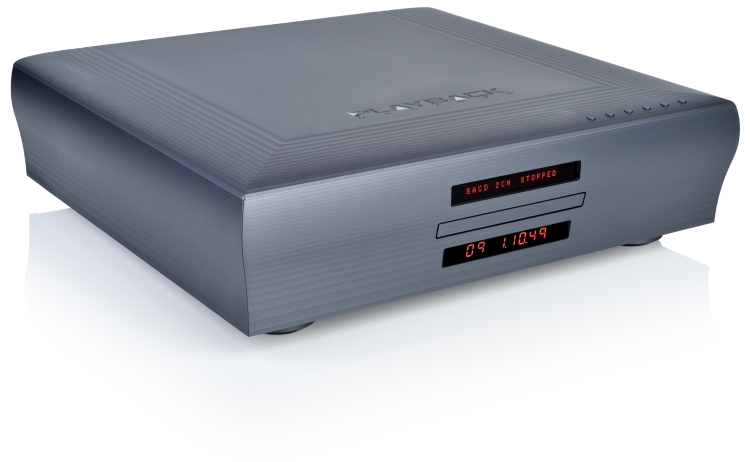






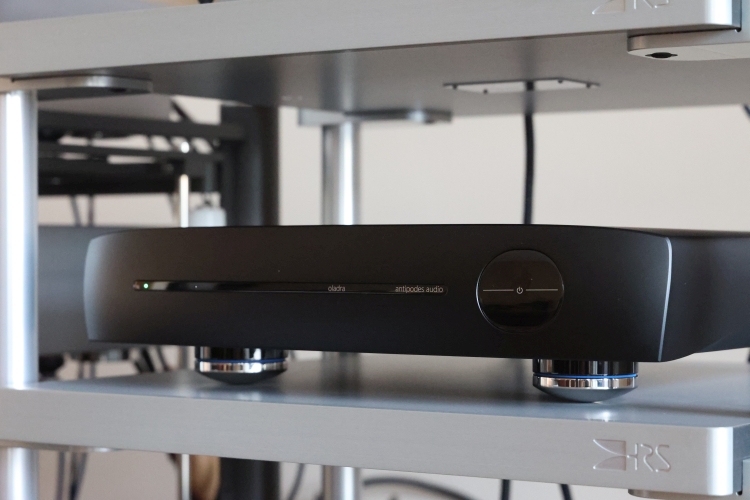
Some of us at the JPLAY forum have tested the JPLAY iOS app, via an RJ-45 cable, from the Audio Network router to a Lightning to Ethernet adapter, connecting the latter to the iPad or iPhone, with impressive results. If you still have the XACT S1, you might want to look into it. Carlos
You mentioned that the JPLAY for iOS app runs on iPads and iPhones, and although it is not officially endorsed for MacOS it runs perfectly fine on the original M1 MacBook Air as well.
Marcin told me that a Mx MacBook with JPLAY for iOS running on it can output directly via USB to DAC.
So it might be possible that this software gives the Macbook a nice uplift in SQ.
Did you try this?
Thanks
Hi Matt, Although it might indeed work and sound decent enough, I’d be hesitant to expect anything beyond that, given that the Macbook has no special power supply, audio interface, or USB hardware. Earlier experiments with several Windows PCs and my previous Intel Macbook Pro did not yield anything spectacular. That said, I have never used my current M1 MacBook with any of my DACs, so I don’t really know:-)
Thank you for your review, Christiaan. I appreciate that you’ve taken the time to evaluate the performance of both the player and server apps, especially noting the shift in hierarchy favoring UPnP/mpd. We previously discussed Squeeze + Squeeze, but unfortunately, it is not compatible with JPLAY. Additionally, your comparison with Taiko (though I understand you won’t review it), Oladra, and CDs helps put sound quality into perspective.
In a high-performing setup, we’re always eager to understand when and how the system performs at its best. You suggest that S1 may benefit from a complementary S1 running bespoke firmware to achieve optimal sound quality. Given the meticulous attention to detail—from the specially-selected industrial-grade 4TB SSD with the XACT Link drive cable to the highly durable OS SD card designed for military conditions—it seems clear that playing local files represents the pinnacle of sound quality in a single S1 unit, followed (closely) by streaming from Tidal or Qobuz.
Is that correct, or am I mistaken? If you did compare with differnent file types that also would be very interesting to know.
All the best,
Paul
Hi Paul, I’ve not heard the dual S1 setup. That part is added for information only.
The SQ delta between local and streaming depends on a few variables, an important one of which is the recording date. Recent files often sound better streaming than when ripped from a CD. For older albums, it can go both ways, especially when comparing originals with remasters. But under equal circumstances, more often than not, local is better.
When comparing purchased and downloaded Qobuz files, I tried WAV and FLAC but can’t be sure which is the master format. It could very well be FLACs, from which the WAVs are derived. In any case, in these particular circumstances, local WAV sounds best, followed by local FLAC, and then streaming. However, the differences are quite small, especially between local FLAC and streaming FLAC. Ultimately, I find I am very comfortable listening to either source or format, regardless of the small differences.
From all my switch reviews, I know they affect both streaming and local music playback. In other words, the music stream need not actually travel through the switch for the latter to have an effect on the sound.
Thank you for your response. I was already aware of your preference for WAV files and local storage, but I’m curious if this also applies specifically to the S1, given that Marcin emphasized the integration of the local SSD.
It seems we’re constantly at a crossroads between playing from local storage and streaming, with difference in sound quality often diminishing. However, in certain setups—and particularly with certain files like WAV—a noticeable difference can still be heard in 2024. Apologies if I misunderstood your point.
Hi Paul, to clarify, there is still an audible difference between local WAV and streaming FLAC, and this is audible with the Grimm, Antipodes, and XACT S1. The difference is smaller between local FLAC and streaming FLAC. And, sometimes, streaming can be better than a ripped CD. My stance is that the difference is not always large enough to warrant worrying about too much. Marcin is also a huge fan of DSD, and playing DSF files through XACT S1 was an important part of the fine-tuning process. For DSD playback, you obviously need local storage, which helps explain the emphasis.
That makes more sense to me now. I really appreciate it.
Thank you!
In addition to considering how a switch affects local file playback, we should also factor in (any) network noise from the modem all the way to the streamer and dac, and any connected devices, power supplies included.
In sensitive systems, even minor network noise can become noticeable. This might explain why disconnecting the Ethernet cable sometimes improves audio quality, although it’s not a practical solution if you prefer to use well-designed music apps and software.
Regarding file formats, besidesc using the WAV format, achieving optimal sound quality is often best with files that match the original sample rate and bit depth of the recording, provided you can determine those specifications.
Fantastic review, as always Christiaan. You are an asset to the audiophile community, keep up the great work 🙂
Thanks, Watts!
I own a Taiko, Should I sell It for the XCAT?
Given that I also work for Taiko Audio, I need to avoid a conflict of interest. So, I’m afraid I cannot comment on the Taiko Extreme.
Allow me to give it a try. Based on the review, it seems that the XACT S1 is a strong contender but if price isn’t a concern, it might not quite reach the level of the top-tier servers like the Antipodes Oladra or Taiko Audio Extreme.
That said, it’s an important question to consider. Also, do you currently own a Taiko + a network card + an Extreme Switch + an Extreme Router?
If you lean towards local files, Marcin (and likely Emile as well) have put considerable effort into optimizing local playback. What types of files do you typically play?
Ultimately, they each have distinct sound qualities, so your decision will come down to what suits your listening preferences best. Happy listening!
I own the USB card, a sotm switch with clk inside and a super clock sotm. I used sotm linear power supply for both and 2 Sotm Ethernet with filters cat7 and one stack audio Ethernet filter. My Dac is apl sr mk2, have kondo g700/melius Accu A80, TAD cr1tx
I assume you’re primarily focused on streaming, which makes sense given the attention you’ve paid to your network. Even upgrading the router’s power supply could make a difference.
Perhaps Christian could help you by identifying the distinct sound characteristics of the Taiko, Oladra, and XACT S1 without preference. If anyone can articulate the sometimes subtle audible differences between them, it’s him!
Thanks Paul, I have a Sotm power supply too on my internet box.
(-:
All I can say is that the two severs sound very different. One is not better than the other, but they do have different perspectives, making it a personal matter. Also, the two employ different music playback suites (UPnP/JPLAY and Roon). What I would recommend is to audition the XACT S1 next to the Extreme to form your own opinion.
Thanks Peter, I leave close to Lille, I think you too? If one day possible to make an audition. Edward is installing last version of XDMS at same time I make my email. I will saw what it will able to do
If you’re open to all possibilities and recognize the potential of networks and switches in high-end audio—especially after hearing it yourself—why not consider selling the Taiko for two XACT S1 units with a few recommended JCAT cables? It seems that “the XACT S1 can be paired with a second S1 to achieve the best sound quality. Of course first we keep waiting for further audible insights from Christiaan 😉
If I recall correctly, Marcin mentioned that he connects directly to the router (or box) and either disconnects his iPad or uses a wired connection. Given that, with a S1 combo you might also consider selling the SoTM switch with the internal clock, along with the Super Clock SoTM, SoTM linear power supply for both, two SoTM Ethernet cables with filters (Cat7), and one Stack Audio Ethernet filter.
Hello, Thank you for the marvelous reviews you provide! Always a pleasure to read them.
I bought a Weiss Helios DAC. It has not arrived yet. Meanwhile, I’m shopping for a server/streamer. The two that sound most compatible to me on paper are the K22 and now the Xact. Different profiles to be sure. I’ve heard the Oladra. So, I understand the house sound. But, I’ve not heard an Xact—and it’s likely that the only way to do this is to buy one. And so, I write to ask.
I have Pass xa60.8 monos and an XP-32 preamp. Like you’ve experienced, I’m trending away from the romantic and will replace them as I can, in favor of Gryphon Diablo 333.
I have Magico A5 speakers.
Which of these two streamers is the best match (short term or long term or both)?
Thank you in advance for your insight!
Hi John, honestly, it depends on your personal sonic preferences, as well as the software you want to use. Antipodes offers a complete software suite while the XACT S1 offers only UPnP. That said, the sonic differences will be a more decisive factor. Antipodes has an earthier and beefier, more full-bodied sound, especially the K22, while the XACT has an airier and more delicate sound. Although I have not directly compared the K22 with the XACT S1, I did review all Antipodes models, and know how they compare. The K22 offers great value for money, but is not quite as articulate, refined, or highly resolving as the Oladra or the XACT S1.
Thank you Christiaan (and Paul)! Those are all good things for me to consider.
“The two that sound most compatible to me on paper are the K22 and now the Xact.”
You’ve chosen a very advanced DAC with various inputs, so I think you should carefully consider which output you prefer from your server. The Xact can only output through USB, so you’ll be limited to that option. Additionally, the K22 is a medium-powered server, which might partially explain its more romantic sound signature. In contrast, the K50, being higher-powered, should sound more agile.
You didn’t mention whether you prefer streaming or local files, and that’s an important consideration too. Both servers perform best with local files streamed from a Samsung PM893 SSD (preinstalled in the Xact).
All Antipodes devices with digital outputs include an additional reclocking/regenerating stage compared to the USB output. The Oladra, however, has an extra reclocking/regenerating stage for both USB and digital outputs compared to the other devices.
Given your budget and sound preferences, you really should (at the very least) audition the Xact and a higher-end Antipodes model.
Would you kindly point out if hfa favourite is higher or lower than highly recommended
Many thanks
Hi Mark, That is an understandable question, which is answered in the intro on the Awards page. Basically, they have the same ranking, but Favorite components are actually part of my inventory, meaning they are also actively used.